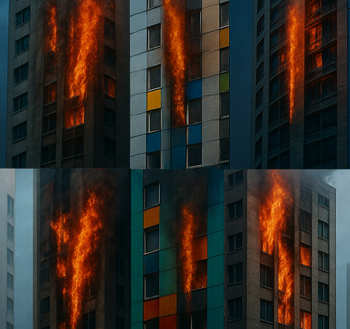Heat recovery for buildings
Heat recovery is the process of collecting and re-using heat that is generated from any process where the heat would otherwise be lost (ref. The Carbon Trust, 2011). This can help reduce the energy consumption of the process or the heat can be used elsewhere, reducing running costs and carbon emissions.
Heat recovery devices can be used in most buildings since the majority use energy for heating, cooling, ventilation or some may house industrial processes that generate heat.
Sources of waste heat that might provide opportunities heat recovery include:
- Ventilation systems.
- Refrigeration units and chiller units.
- Boilers.
- Power generation plant.
- Plant cooling systems.
- Hot liquid effluents and high-temperature exhaust gasses.
This 'waste' heat can be recovered and re-used for applications such as; heating water, pre-heating fresh air for building ventilation systems, drying processes, power generation, pre-heating combustion air for furnaces, boilers and so on.
Heat recovery refers to the process of capturing and reusing waste heat that is generated from industrial or commercial processes. There are several types of heat recovery which include;
- Air-to-air heat recovery is a type of heat recovery involves exchanging heat between two separate air streams, such as ventilation air and exhaust air as in MVHR systems.
- Air-to-air mixing direct ducting of waste hot air in to other areas to use the heat perhaps through filters.
- Liquid-to-liquid (water-to-water) heat recovery is a type of heat recovery involves exchanging heat between two separate waterstreams, such as hot water and cold water, commonly used in manufacturing plants.
- Refrigerant-to-air heat recovery is a type of heat recovery involves capturing waste heat from a refrigeration system and using it to preheat incoming air, commonly used in HVAC plant and can improve energy efficiency.
- Steam-to-steam heat recovery is a type of heat recovery involves exchanging heat between two separate steam streams, such as high-pressure steam and low-pressure steam often used in power plants and industrial processes.
- Exhaust gas heat recovery is a type of heat recovery involves capturing waste heat from exhaust gases and using it to generate steam or hot water, commonly used in boilers and furnaces.
- Waste heat recovery from engines is a type of heat recovery that captures waste heat from engines and uses it to generate electricity or to preheat incoming air or fuel, common in condensers, power plants and industrial processes.
- Solid to solid heat recovery may refer to chemical heat that is captured by phase change materials and released again on phase change. It may be a form of heat recovery if the heat used to change phases initially was waste heat
- Phase heat recovery may refer to chemical heat that is captured by phase change materials and released again on phase change. It may be a form of heat recovery if the heat used to change phases initially was waste heat.
- Solids in heat recovery might be referred to a regenerative, as this is where waste heat with in air or water heats a solid as it passes, the solid material retains that heat and acts in a similar way to a battery, releasing it as a fresh elements comes in contact with it, such as single room ventilators.
The government document The Future of Heating: Meeting the Challenge (March 2013) highlighted the potential of heat recovery for helping reduce UK carbon emissions. In June 2013, a more detailed study was commissioned which found a total of 48 terrawatt-hours (TWh) per year of industrial waste heat across eight energy intensive industries; oil refining, iron and steel, food and drink, pulp and paper, chemical, glass, cement and ceramics. It identified 11 TWh/yr with technical potential and 8 TWh/yr with economic potential. The study identified commercially viable heat recovery for all eight industries.
In February 2023 the Guardian reported on the report published by Danfoss noted in their heat excess whitepaper that excess heat is the world’s largest untapped source of energy indicating that in the EU alone, excess heat amounts to 2,860 TWh/y, almost corresponding to the EU’s total energy demand for heat and hot water in residential and service sector buildings. Much of this excess heat could instead be captured and reused.
NB Approved document F: Volume 1: Dwellings, 2021 edition, defines heat recovery as: ‘Applied to mechanical supply and extract systems or a single room ventilator, extract air is passed over a heat exchanger and the recovered heat is put into the supply air.’
[edit] Related articles on Designing Buildings
- Air conditioning.
- Air handling unit.
- Chiller unit.
- Coefficient of Performance CoP.
- District energy.
- Ecobuild 2016 - Making the business case for large scale retrofit investment.
- Exhaust air heat pump.
- Geothermal pile foundations.
- Gross calorific value.
- Heat exchanger.
- Heat pump.
- Heat recovery ventilation.
- Heat source.
- Heating.
- HVAC.
- Mechanical ventilation.
- Mechanical ventilation's role in improving indoor air quality.
- Refrigerants.
- Tempering heating.
- Types of heating system.
- Types of heat exchanger.
- Variable refrigerant flow.
- Waste heat.
- Zero Bills Home.
[edit] External references
Featured articles and news
Government consultations for the summer of 2025
A year of Labour, past and present consultations on the environment, the built environment, training and tax.
CMA competitiveness probe of major housing developers
100 million affordable housing contributions committed with further consultation published.
Homes England supports Greencore Homes
42 new build affordable sustainable homes in Oxfordshire.
Zero carbon social housing: unlocking brownfield potential
Seven ZEDpod strategies for brownfield housing success.
CIOB report; a blueprint for SDGs and the built environment
Pairing the Sustainable Development Goals with projects.
Types, tests, standards and fires relating to external cladding
Brief descriptions with an extensive list of fires for review.
Latest Build UK Building Safety Regime explainer published
Key elements in one short, now updated document.
UKGBC launch the UK Climate Resilience Roadmap
First guidance of its kind on direct climate impacts for the built environment and how it can adapt.
CLC Health, Safety and Wellbeing Strategy 2025
Launched by the Minister for Industry to look at fatalities on site, improving mental health and other issues.
One of the most impressive Victorian architects. Book review.
Common Assessment Standard now with building safety
New CAS update now includes mandatory building safety questions.
RTPI leader to become new CIOB Chief Executive Officer
Dr Victoria Hills MRTPI, FICE to take over after Caroline Gumble’s departure.
Social and affordable housing, a long term plan for delivery
The “Delivering a Decade of Renewal for Social and Affordable Housing” strategy sets out future path.
A change to adoptive architecture
Effects of global weather warming on architectural detailing, material choice and human interaction.
The proposed publicly owned and backed subsidiary of Homes England, to facilitate new homes.
How big is the problem and what can we do to mitigate the effects?
Overheating guidance and tools for building designers
A number of cool guides to help with the heat.
The UK's Modern Industrial Strategy: A 10 year plan
Previous consultation criticism, current key elements and general support with some persisting reservations.
Building Safety Regulator reforms
New roles, new staff and a new fast track service pave the way for a single construction regulator.
























